Barriers to Equitable Healthcare Access for Aboriginal Australians and Torres Strait Islanders
VerifiedAdded on 2023/01/18
|11
|3101
|58
AI Summary
This research explores the barriers to equitable healthcare access for Aboriginal Australians and Torres Strait Islanders. It discusses the inequalities in health and social well-being for this vulnerable population, including cultural barriers, language and communication issues, and the impact of racism. The research methodology involves a phenomenological approach, with data collected through interviews with Aboriginal and Torres Strait Islander individuals living in remote areas of Australia.
Contribute Materials
Your contribution can guide someone’s learning journey. Share your
documents today.
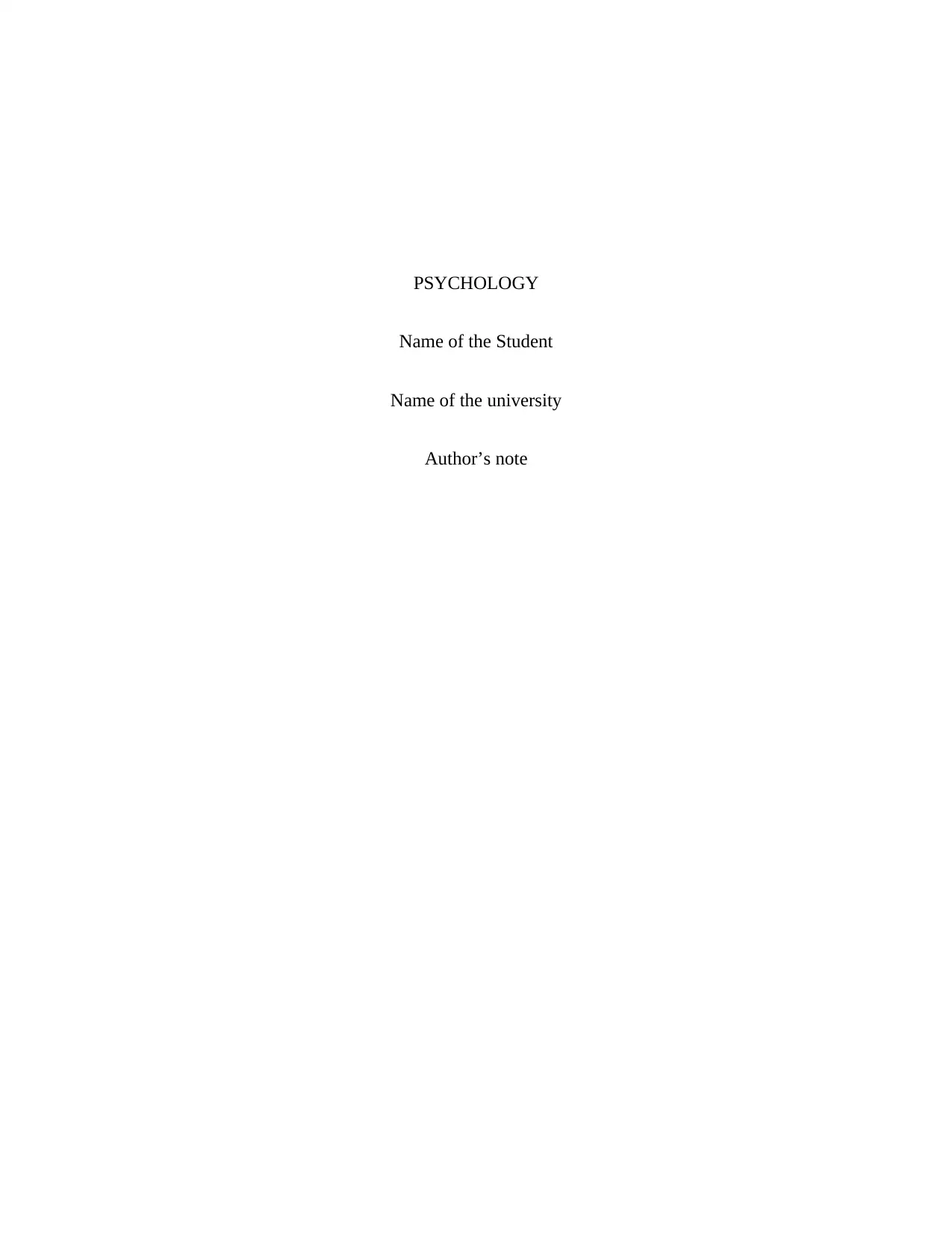
PSYCHOLOGY
Name of the Student
Name of the university
Author’s note
Name of the Student
Name of the university
Author’s note
Secure Best Marks with AI Grader
Need help grading? Try our AI Grader for instant feedback on your assignments.
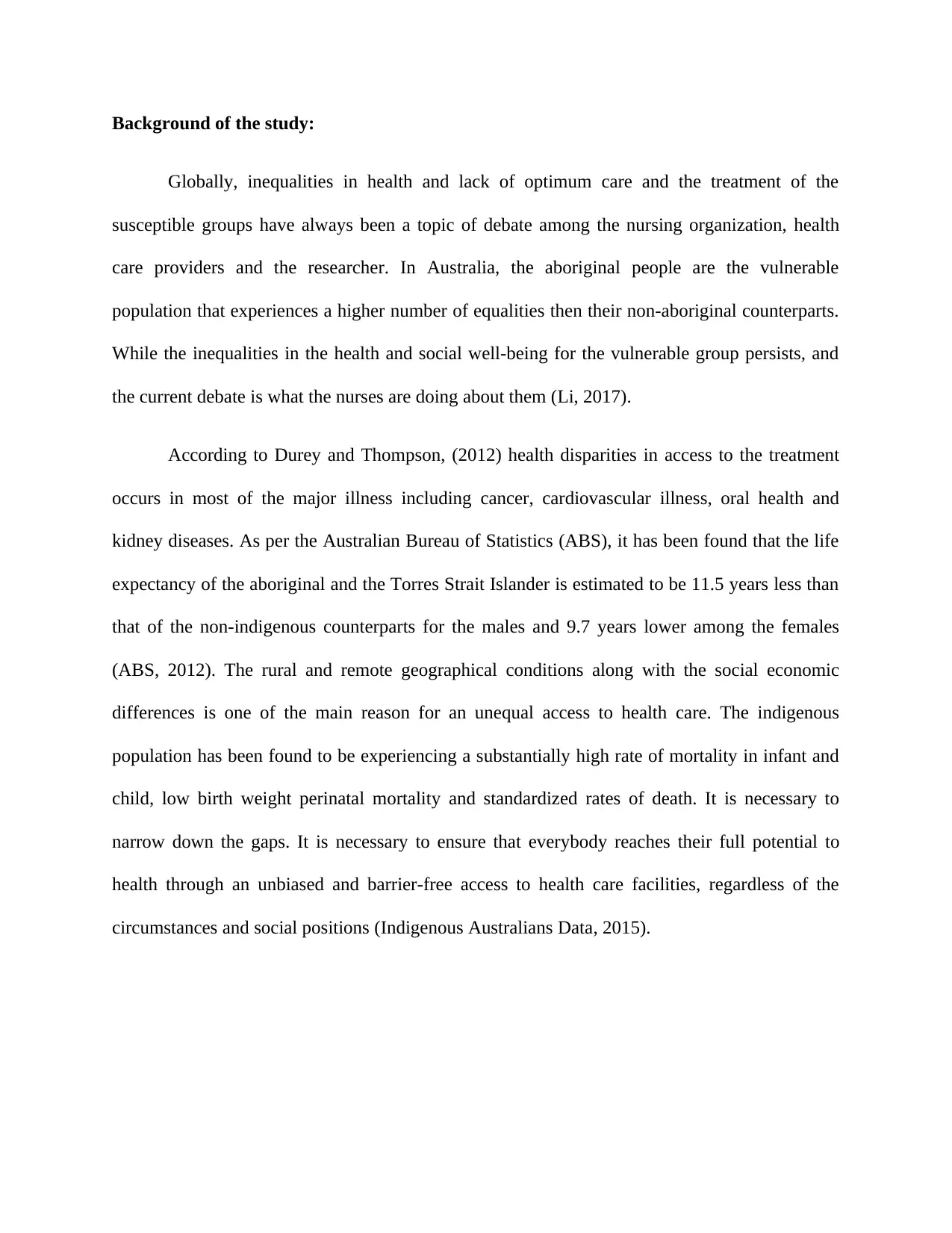
Background of the study:
Globally, inequalities in health and lack of optimum care and the treatment of the
susceptible groups have always been a topic of debate among the nursing organization, health
care providers and the researcher. In Australia, the aboriginal people are the vulnerable
population that experiences a higher number of equalities then their non-aboriginal counterparts.
While the inequalities in the health and social well-being for the vulnerable group persists, and
the current debate is what the nurses are doing about them (Li, 2017).
According to Durey and Thompson, (2012) health disparities in access to the treatment
occurs in most of the major illness including cancer, cardiovascular illness, oral health and
kidney diseases. As per the Australian Bureau of Statistics (ABS), it has been found that the life
expectancy of the aboriginal and the Torres Strait Islander is estimated to be 11.5 years less than
that of the non-indigenous counterparts for the males and 9.7 years lower among the females
(ABS, 2012). The rural and remote geographical conditions along with the social economic
differences is one of the main reason for an unequal access to health care. The indigenous
population has been found to be experiencing a substantially high rate of mortality in infant and
child, low birth weight perinatal mortality and standardized rates of death. It is necessary to
narrow down the gaps. It is necessary to ensure that everybody reaches their full potential to
health through an unbiased and barrier-free access to health care facilities, regardless of the
circumstances and social positions (Indigenous Australians Data, 2015).
Globally, inequalities in health and lack of optimum care and the treatment of the
susceptible groups have always been a topic of debate among the nursing organization, health
care providers and the researcher. In Australia, the aboriginal people are the vulnerable
population that experiences a higher number of equalities then their non-aboriginal counterparts.
While the inequalities in the health and social well-being for the vulnerable group persists, and
the current debate is what the nurses are doing about them (Li, 2017).
According to Durey and Thompson, (2012) health disparities in access to the treatment
occurs in most of the major illness including cancer, cardiovascular illness, oral health and
kidney diseases. As per the Australian Bureau of Statistics (ABS), it has been found that the life
expectancy of the aboriginal and the Torres Strait Islander is estimated to be 11.5 years less than
that of the non-indigenous counterparts for the males and 9.7 years lower among the females
(ABS, 2012). The rural and remote geographical conditions along with the social economic
differences is one of the main reason for an unequal access to health care. The indigenous
population has been found to be experiencing a substantially high rate of mortality in infant and
child, low birth weight perinatal mortality and standardized rates of death. It is necessary to
narrow down the gaps. It is necessary to ensure that everybody reaches their full potential to
health through an unbiased and barrier-free access to health care facilities, regardless of the
circumstances and social positions (Indigenous Australians Data, 2015).
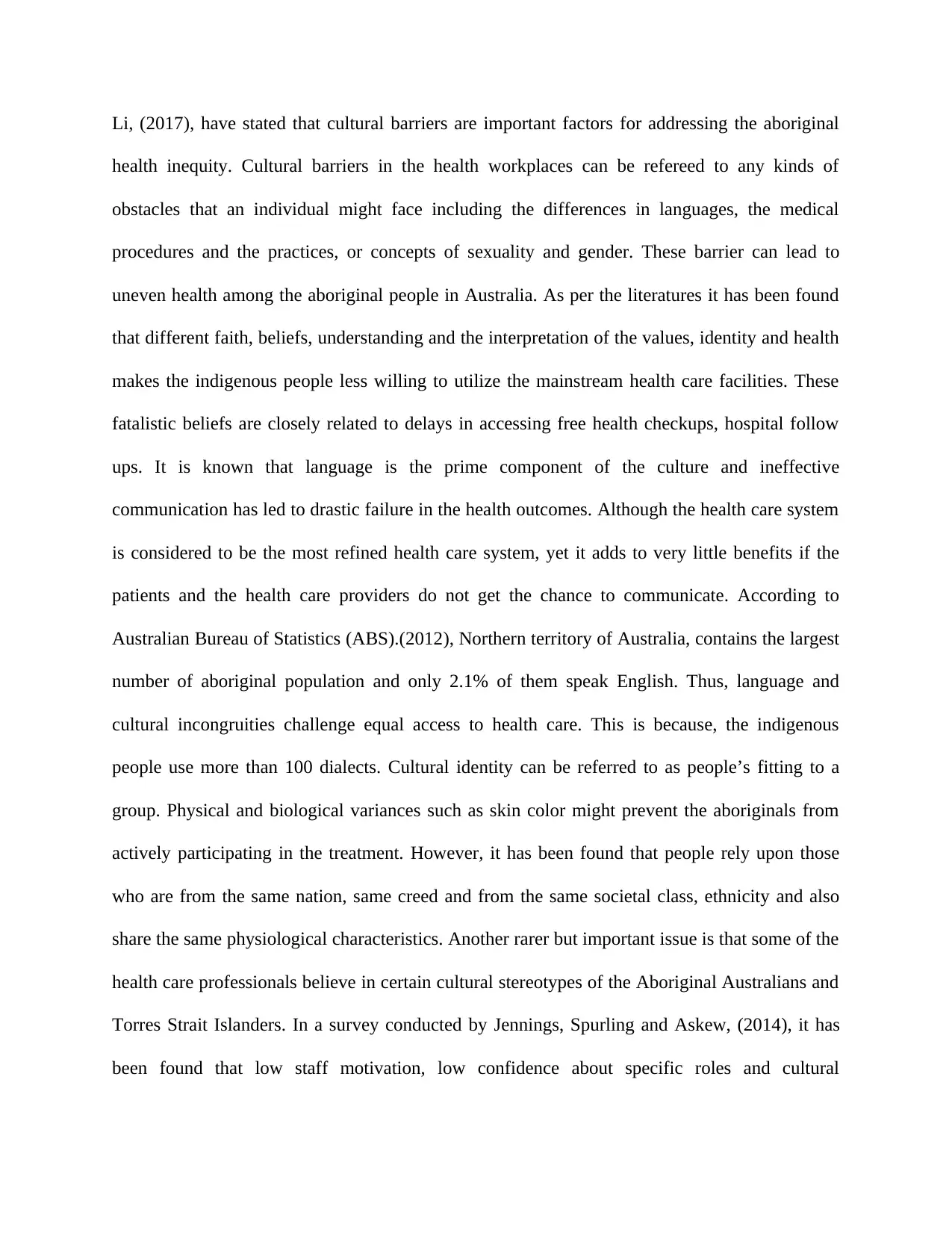
Li, (2017), have stated that cultural barriers are important factors for addressing the aboriginal
health inequity. Cultural barriers in the health workplaces can be refereed to any kinds of
obstacles that an individual might face including the differences in languages, the medical
procedures and the practices, or concepts of sexuality and gender. These barrier can lead to
uneven health among the aboriginal people in Australia. As per the literatures it has been found
that different faith, beliefs, understanding and the interpretation of the values, identity and health
makes the indigenous people less willing to utilize the mainstream health care facilities. These
fatalistic beliefs are closely related to delays in accessing free health checkups, hospital follow
ups. It is known that language is the prime component of the culture and ineffective
communication has led to drastic failure in the health outcomes. Although the health care system
is considered to be the most refined health care system, yet it adds to very little benefits if the
patients and the health care providers do not get the chance to communicate. According to
Australian Bureau of Statistics (ABS).(2012), Northern territory of Australia, contains the largest
number of aboriginal population and only 2.1% of them speak English. Thus, language and
cultural incongruities challenge equal access to health care. This is because, the indigenous
people use more than 100 dialects. Cultural identity can be referred to as people’s fitting to a
group. Physical and biological variances such as skin color might prevent the aboriginals from
actively participating in the treatment. However, it has been found that people rely upon those
who are from the same nation, same creed and from the same societal class, ethnicity and also
share the same physiological characteristics. Another rarer but important issue is that some of the
health care professionals believe in certain cultural stereotypes of the Aboriginal Australians and
Torres Strait Islanders. In a survey conducted by Jennings, Spurling and Askew, (2014), it has
been found that low staff motivation, low confidence about specific roles and cultural
health inequity. Cultural barriers in the health workplaces can be refereed to any kinds of
obstacles that an individual might face including the differences in languages, the medical
procedures and the practices, or concepts of sexuality and gender. These barrier can lead to
uneven health among the aboriginal people in Australia. As per the literatures it has been found
that different faith, beliefs, understanding and the interpretation of the values, identity and health
makes the indigenous people less willing to utilize the mainstream health care facilities. These
fatalistic beliefs are closely related to delays in accessing free health checkups, hospital follow
ups. It is known that language is the prime component of the culture and ineffective
communication has led to drastic failure in the health outcomes. Although the health care system
is considered to be the most refined health care system, yet it adds to very little benefits if the
patients and the health care providers do not get the chance to communicate. According to
Australian Bureau of Statistics (ABS).(2012), Northern territory of Australia, contains the largest
number of aboriginal population and only 2.1% of them speak English. Thus, language and
cultural incongruities challenge equal access to health care. This is because, the indigenous
people use more than 100 dialects. Cultural identity can be referred to as people’s fitting to a
group. Physical and biological variances such as skin color might prevent the aboriginals from
actively participating in the treatment. However, it has been found that people rely upon those
who are from the same nation, same creed and from the same societal class, ethnicity and also
share the same physiological characteristics. Another rarer but important issue is that some of the
health care professionals believe in certain cultural stereotypes of the Aboriginal Australians and
Torres Strait Islanders. In a survey conducted by Jennings, Spurling and Askew, (2014), it has
been found that low staff motivation, low confidence about specific roles and cultural
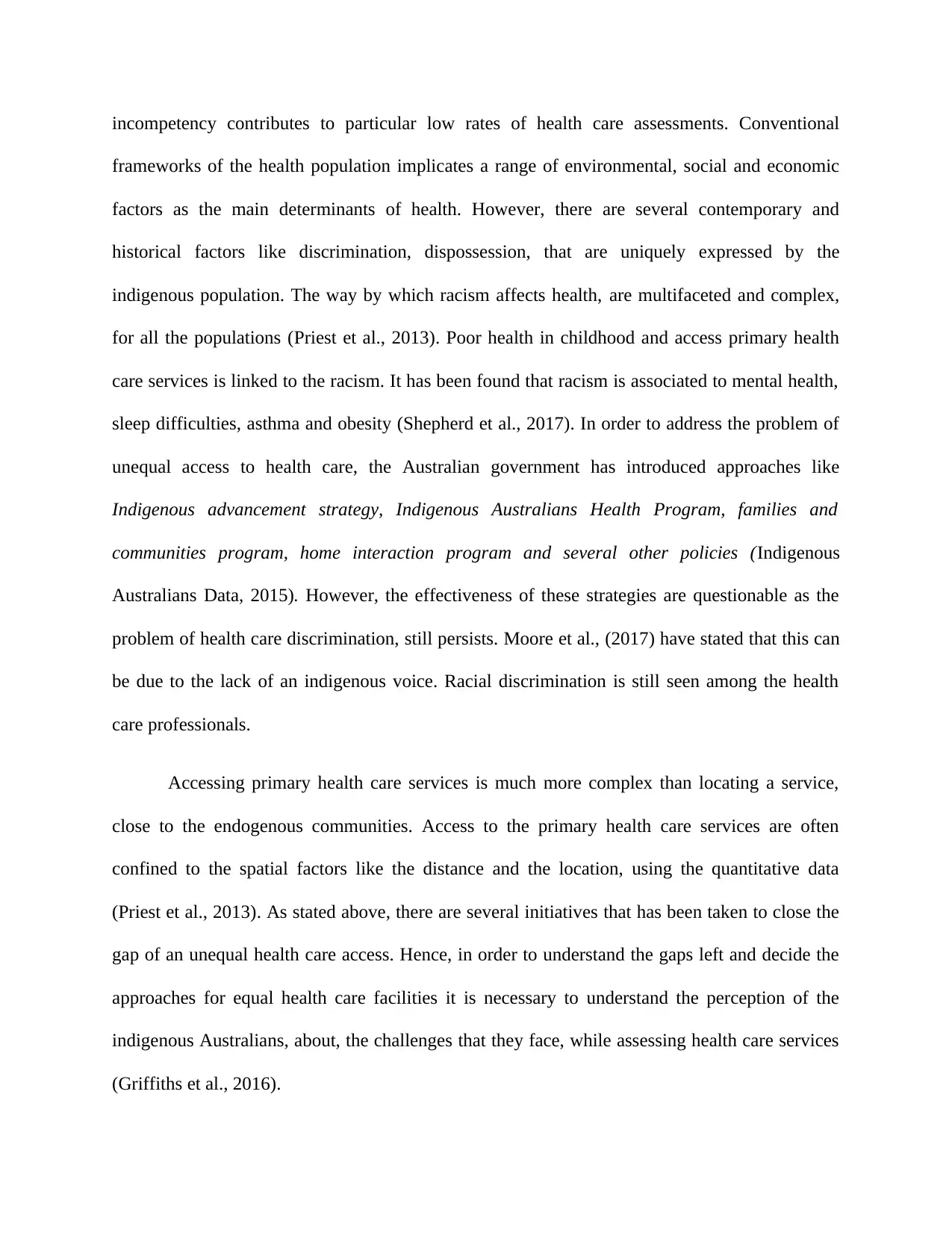
incompetency contributes to particular low rates of health care assessments. Conventional
frameworks of the health population implicates a range of environmental, social and economic
factors as the main determinants of health. However, there are several contemporary and
historical factors like discrimination, dispossession, that are uniquely expressed by the
indigenous population. The way by which racism affects health, are multifaceted and complex,
for all the populations (Priest et al., 2013). Poor health in childhood and access primary health
care services is linked to the racism. It has been found that racism is associated to mental health,
sleep difficulties, asthma and obesity (Shepherd et al., 2017). In order to address the problem of
unequal access to health care, the Australian government has introduced approaches like
Indigenous advancement strategy, Indigenous Australians Health Program, families and
communities program, home interaction program and several other policies (Indigenous
Australians Data, 2015). However, the effectiveness of these strategies are questionable as the
problem of health care discrimination, still persists. Moore et al., (2017) have stated that this can
be due to the lack of an indigenous voice. Racial discrimination is still seen among the health
care professionals.
Accessing primary health care services is much more complex than locating a service,
close to the endogenous communities. Access to the primary health care services are often
confined to the spatial factors like the distance and the location, using the quantitative data
(Priest et al., 2013). As stated above, there are several initiatives that has been taken to close the
gap of an unequal health care access. Hence, in order to understand the gaps left and decide the
approaches for equal health care facilities it is necessary to understand the perception of the
indigenous Australians, about, the challenges that they face, while assessing health care services
(Griffiths et al., 2016).
frameworks of the health population implicates a range of environmental, social and economic
factors as the main determinants of health. However, there are several contemporary and
historical factors like discrimination, dispossession, that are uniquely expressed by the
indigenous population. The way by which racism affects health, are multifaceted and complex,
for all the populations (Priest et al., 2013). Poor health in childhood and access primary health
care services is linked to the racism. It has been found that racism is associated to mental health,
sleep difficulties, asthma and obesity (Shepherd et al., 2017). In order to address the problem of
unequal access to health care, the Australian government has introduced approaches like
Indigenous advancement strategy, Indigenous Australians Health Program, families and
communities program, home interaction program and several other policies (Indigenous
Australians Data, 2015). However, the effectiveness of these strategies are questionable as the
problem of health care discrimination, still persists. Moore et al., (2017) have stated that this can
be due to the lack of an indigenous voice. Racial discrimination is still seen among the health
care professionals.
Accessing primary health care services is much more complex than locating a service,
close to the endogenous communities. Access to the primary health care services are often
confined to the spatial factors like the distance and the location, using the quantitative data
(Priest et al., 2013). As stated above, there are several initiatives that has been taken to close the
gap of an unequal health care access. Hence, in order to understand the gaps left and decide the
approaches for equal health care facilities it is necessary to understand the perception of the
indigenous Australians, about, the challenges that they face, while assessing health care services
(Griffiths et al., 2016).
Secure Best Marks with AI Grader
Need help grading? Try our AI Grader for instant feedback on your assignments.
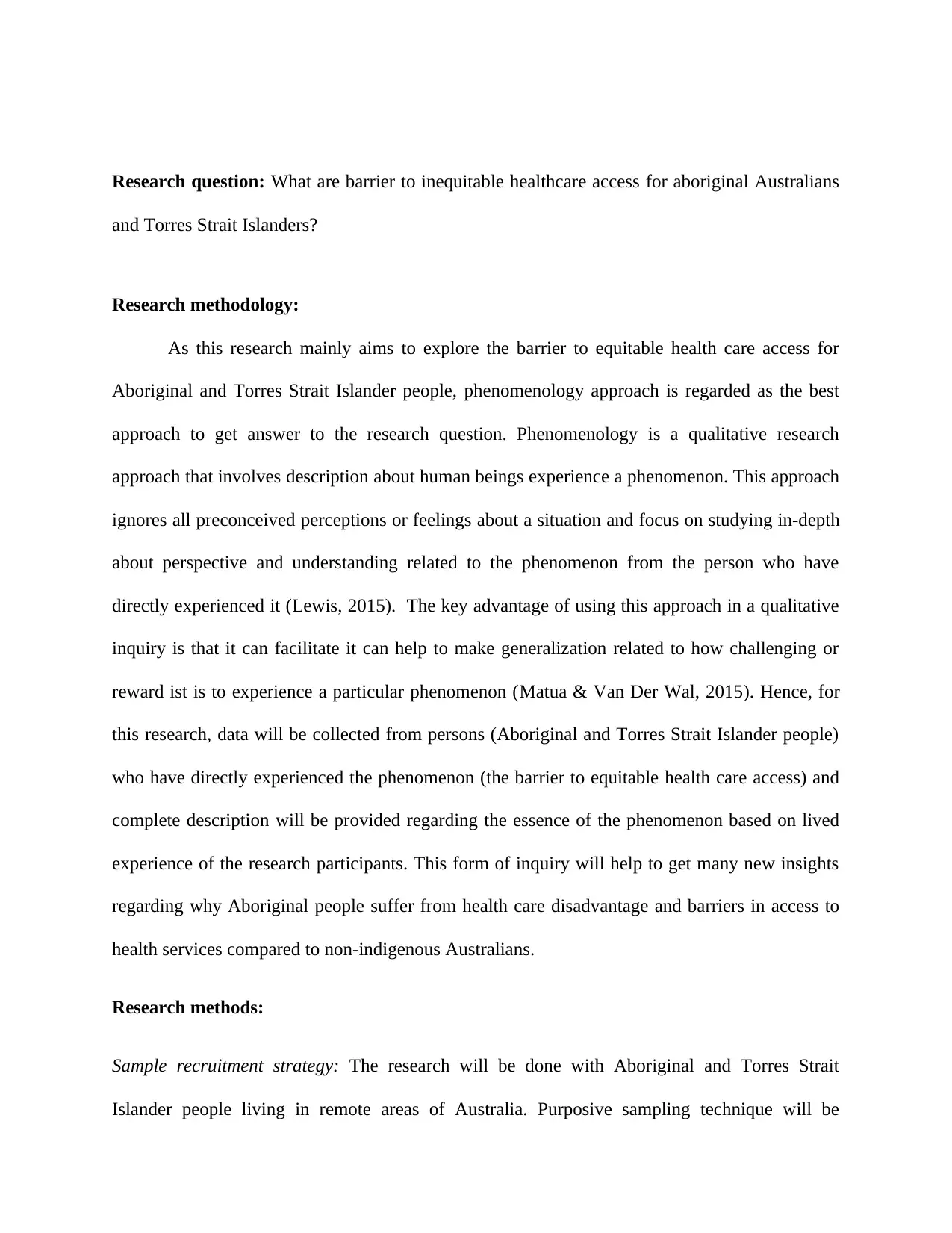
Research question: What are barrier to inequitable healthcare access for aboriginal Australians
and Torres Strait Islanders?
Research methodology:
As this research mainly aims to explore the barrier to equitable health care access for
Aboriginal and Torres Strait Islander people, phenomenology approach is regarded as the best
approach to get answer to the research question. Phenomenology is a qualitative research
approach that involves description about human beings experience a phenomenon. This approach
ignores all preconceived perceptions or feelings about a situation and focus on studying in-depth
about perspective and understanding related to the phenomenon from the person who have
directly experienced it (Lewis, 2015). The key advantage of using this approach in a qualitative
inquiry is that it can facilitate it can help to make generalization related to how challenging or
reward ist is to experience a particular phenomenon (Matua & Van Der Wal, 2015). Hence, for
this research, data will be collected from persons (Aboriginal and Torres Strait Islander people)
who have directly experienced the phenomenon (the barrier to equitable health care access) and
complete description will be provided regarding the essence of the phenomenon based on lived
experience of the research participants. This form of inquiry will help to get many new insights
regarding why Aboriginal people suffer from health care disadvantage and barriers in access to
health services compared to non-indigenous Australians.
Research methods:
Sample recruitment strategy: The research will be done with Aboriginal and Torres Strait
Islander people living in remote areas of Australia. Purposive sampling technique will be
and Torres Strait Islanders?
Research methodology:
As this research mainly aims to explore the barrier to equitable health care access for
Aboriginal and Torres Strait Islander people, phenomenology approach is regarded as the best
approach to get answer to the research question. Phenomenology is a qualitative research
approach that involves description about human beings experience a phenomenon. This approach
ignores all preconceived perceptions or feelings about a situation and focus on studying in-depth
about perspective and understanding related to the phenomenon from the person who have
directly experienced it (Lewis, 2015). The key advantage of using this approach in a qualitative
inquiry is that it can facilitate it can help to make generalization related to how challenging or
reward ist is to experience a particular phenomenon (Matua & Van Der Wal, 2015). Hence, for
this research, data will be collected from persons (Aboriginal and Torres Strait Islander people)
who have directly experienced the phenomenon (the barrier to equitable health care access) and
complete description will be provided regarding the essence of the phenomenon based on lived
experience of the research participants. This form of inquiry will help to get many new insights
regarding why Aboriginal people suffer from health care disadvantage and barriers in access to
health services compared to non-indigenous Australians.
Research methods:
Sample recruitment strategy: The research will be done with Aboriginal and Torres Strait
Islander people living in remote areas of Australia. Purposive sampling technique will be
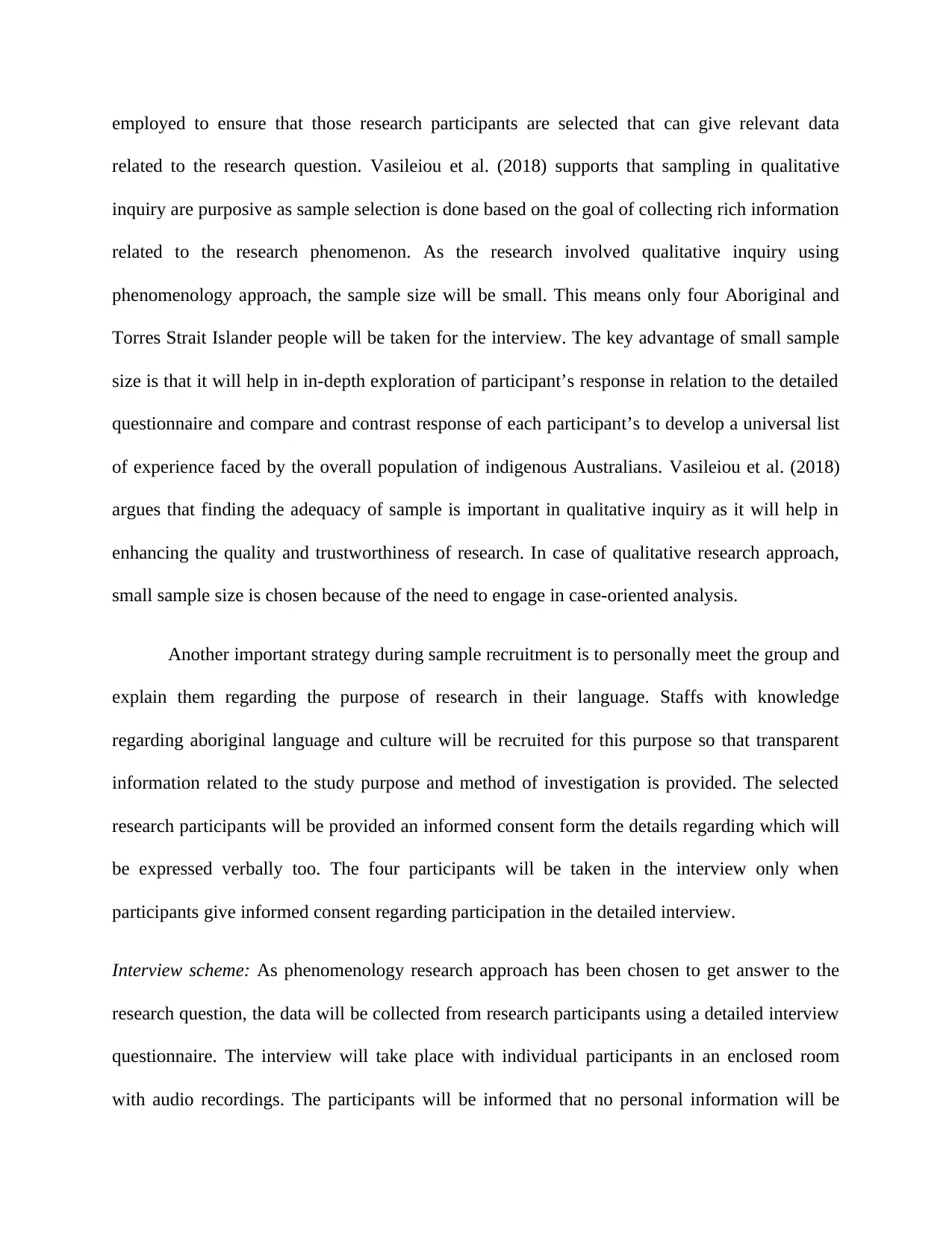
employed to ensure that those research participants are selected that can give relevant data
related to the research question. Vasileiou et al. (2018) supports that sampling in qualitative
inquiry are purposive as sample selection is done based on the goal of collecting rich information
related to the research phenomenon. As the research involved qualitative inquiry using
phenomenology approach, the sample size will be small. This means only four Aboriginal and
Torres Strait Islander people will be taken for the interview. The key advantage of small sample
size is that it will help in in-depth exploration of participant’s response in relation to the detailed
questionnaire and compare and contrast response of each participant’s to develop a universal list
of experience faced by the overall population of indigenous Australians. Vasileiou et al. (2018)
argues that finding the adequacy of sample is important in qualitative inquiry as it will help in
enhancing the quality and trustworthiness of research. In case of qualitative research approach,
small sample size is chosen because of the need to engage in case-oriented analysis.
Another important strategy during sample recruitment is to personally meet the group and
explain them regarding the purpose of research in their language. Staffs with knowledge
regarding aboriginal language and culture will be recruited for this purpose so that transparent
information related to the study purpose and method of investigation is provided. The selected
research participants will be provided an informed consent form the details regarding which will
be expressed verbally too. The four participants will be taken in the interview only when
participants give informed consent regarding participation in the detailed interview.
Interview scheme: As phenomenology research approach has been chosen to get answer to the
research question, the data will be collected from research participants using a detailed interview
questionnaire. The interview will take place with individual participants in an enclosed room
with audio recordings. The participants will be informed that no personal information will be
related to the research question. Vasileiou et al. (2018) supports that sampling in qualitative
inquiry are purposive as sample selection is done based on the goal of collecting rich information
related to the research phenomenon. As the research involved qualitative inquiry using
phenomenology approach, the sample size will be small. This means only four Aboriginal and
Torres Strait Islander people will be taken for the interview. The key advantage of small sample
size is that it will help in in-depth exploration of participant’s response in relation to the detailed
questionnaire and compare and contrast response of each participant’s to develop a universal list
of experience faced by the overall population of indigenous Australians. Vasileiou et al. (2018)
argues that finding the adequacy of sample is important in qualitative inquiry as it will help in
enhancing the quality and trustworthiness of research. In case of qualitative research approach,
small sample size is chosen because of the need to engage in case-oriented analysis.
Another important strategy during sample recruitment is to personally meet the group and
explain them regarding the purpose of research in their language. Staffs with knowledge
regarding aboriginal language and culture will be recruited for this purpose so that transparent
information related to the study purpose and method of investigation is provided. The selected
research participants will be provided an informed consent form the details regarding which will
be expressed verbally too. The four participants will be taken in the interview only when
participants give informed consent regarding participation in the detailed interview.
Interview scheme: As phenomenology research approach has been chosen to get answer to the
research question, the data will be collected from research participants using a detailed interview
questionnaire. The interview will take place with individual participants in an enclosed room
with audio recordings. The participants will be informed that no personal information will be
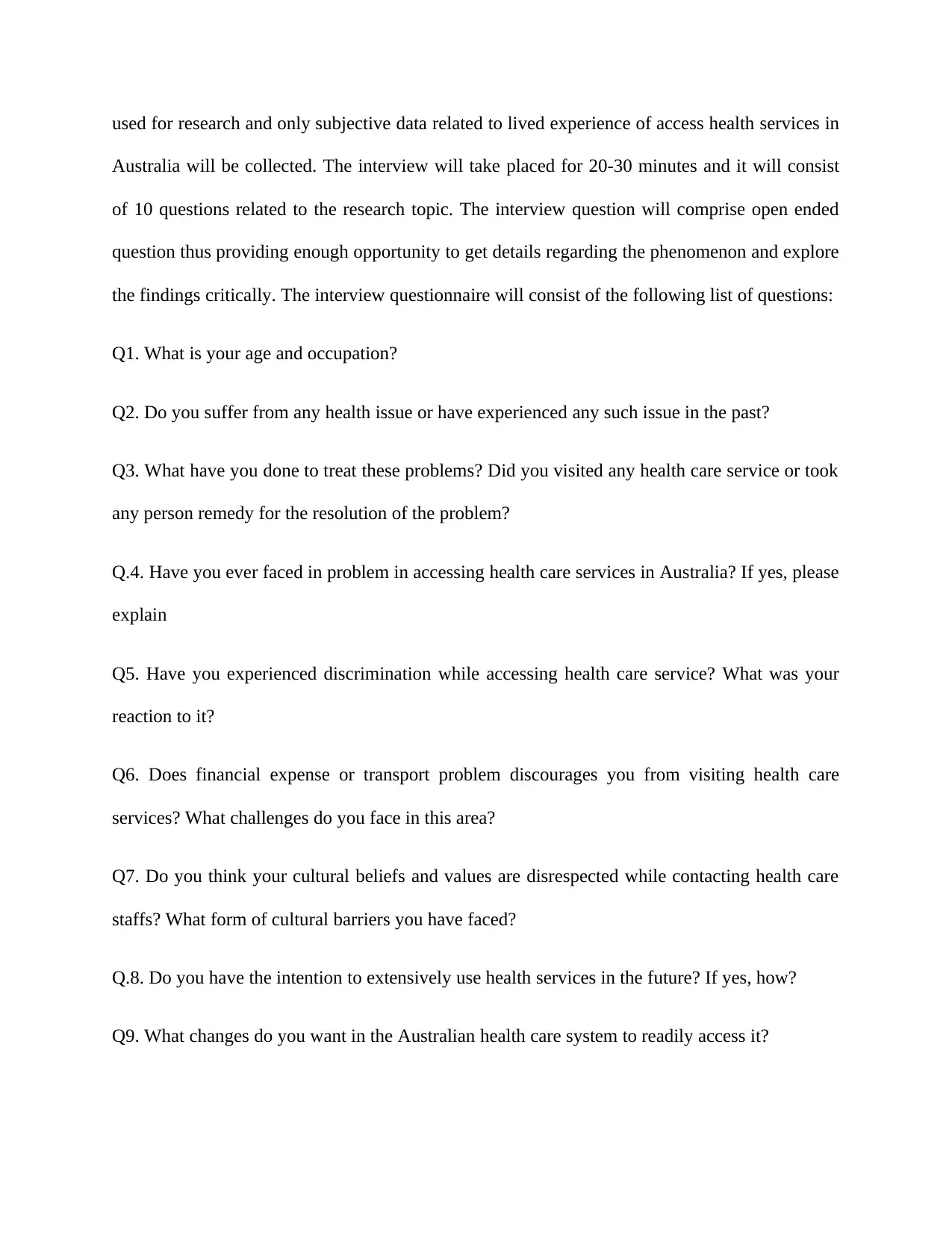
used for research and only subjective data related to lived experience of access health services in
Australia will be collected. The interview will take placed for 20-30 minutes and it will consist
of 10 questions related to the research topic. The interview question will comprise open ended
question thus providing enough opportunity to get details regarding the phenomenon and explore
the findings critically. The interview questionnaire will consist of the following list of questions:
Q1. What is your age and occupation?
Q2. Do you suffer from any health issue or have experienced any such issue in the past?
Q3. What have you done to treat these problems? Did you visited any health care service or took
any person remedy for the resolution of the problem?
Q.4. Have you ever faced in problem in accessing health care services in Australia? If yes, please
explain
Q5. Have you experienced discrimination while accessing health care service? What was your
reaction to it?
Q6. Does financial expense or transport problem discourages you from visiting health care
services? What challenges do you face in this area?
Q7. Do you think your cultural beliefs and values are disrespected while contacting health care
staffs? What form of cultural barriers you have faced?
Q.8. Do you have the intention to extensively use health services in the future? If yes, how?
Q9. What changes do you want in the Australian health care system to readily access it?
Australia will be collected. The interview will take placed for 20-30 minutes and it will consist
of 10 questions related to the research topic. The interview question will comprise open ended
question thus providing enough opportunity to get details regarding the phenomenon and explore
the findings critically. The interview questionnaire will consist of the following list of questions:
Q1. What is your age and occupation?
Q2. Do you suffer from any health issue or have experienced any such issue in the past?
Q3. What have you done to treat these problems? Did you visited any health care service or took
any person remedy for the resolution of the problem?
Q.4. Have you ever faced in problem in accessing health care services in Australia? If yes, please
explain
Q5. Have you experienced discrimination while accessing health care service? What was your
reaction to it?
Q6. Does financial expense or transport problem discourages you from visiting health care
services? What challenges do you face in this area?
Q7. Do you think your cultural beliefs and values are disrespected while contacting health care
staffs? What form of cultural barriers you have faced?
Q.8. Do you have the intention to extensively use health services in the future? If yes, how?
Q9. What changes do you want in the Australian health care system to readily access it?
Paraphrase This Document
Need a fresh take? Get an instant paraphrase of this document with our AI Paraphraser

Q. 10. What are your expectations regarding cost aspects in relation to access to health care
services? Will reduction in cost motivate you to come to contact with health care services?
Personal reflecting writing on the motivation:
The main motivation behind exploring this research question was that I am aware that
many ethnic groups suffer social disadvantages and this has a direct impact on their health and
well-being. I have come across some ethnic people who complain that they are not treated
equally and they experience a stressful life because of poor socioeconomic circumstances and
lack of opportunities to move forward in life. Hence, as Aboriginal and Torres Strait Islanders
are reported to suffer from poor health outcomes compared to other Australians, I was motivated
to meet this people and find out what prevented them from accessing health care services. I
always wanted to inquire whether they are to be blamed for their poor life circumstances or there
are wider society wise disparities that contribute to disparities in health outcome. Hence, this
research gave me the opportunity to direct contact this group and indulge in their lived
experiences related to access to health care services in Australia. This will give me realistic data
regarding what kind of disparities do aboriginal experience in health care setting and who is to be
blamed for disparities in relation to poor access to health service for indigenous people.
Ethical considerations
Researchers carrying out qualitative researches have to be extremely careful while
interacting with the participants and it can be ethically challenging as well. The intimacy and the
relationship that is formed between the researchers and the participants in qualitative studies can
raise a range of ethical concerns and dilemmas like respect for confidentiality, establishment of
open and honest interactions. Disagreement among the different elements like the respondents,
services? Will reduction in cost motivate you to come to contact with health care services?
Personal reflecting writing on the motivation:
The main motivation behind exploring this research question was that I am aware that
many ethnic groups suffer social disadvantages and this has a direct impact on their health and
well-being. I have come across some ethnic people who complain that they are not treated
equally and they experience a stressful life because of poor socioeconomic circumstances and
lack of opportunities to move forward in life. Hence, as Aboriginal and Torres Strait Islanders
are reported to suffer from poor health outcomes compared to other Australians, I was motivated
to meet this people and find out what prevented them from accessing health care services. I
always wanted to inquire whether they are to be blamed for their poor life circumstances or there
are wider society wise disparities that contribute to disparities in health outcome. Hence, this
research gave me the opportunity to direct contact this group and indulge in their lived
experiences related to access to health care services in Australia. This will give me realistic data
regarding what kind of disparities do aboriginal experience in health care setting and who is to be
blamed for disparities in relation to poor access to health service for indigenous people.
Ethical considerations
Researchers carrying out qualitative researches have to be extremely careful while
interacting with the participants and it can be ethically challenging as well. The intimacy and the
relationship that is formed between the researchers and the participants in qualitative studies can
raise a range of ethical concerns and dilemmas like respect for confidentiality, establishment of
open and honest interactions. Disagreement among the different elements like the respondents,
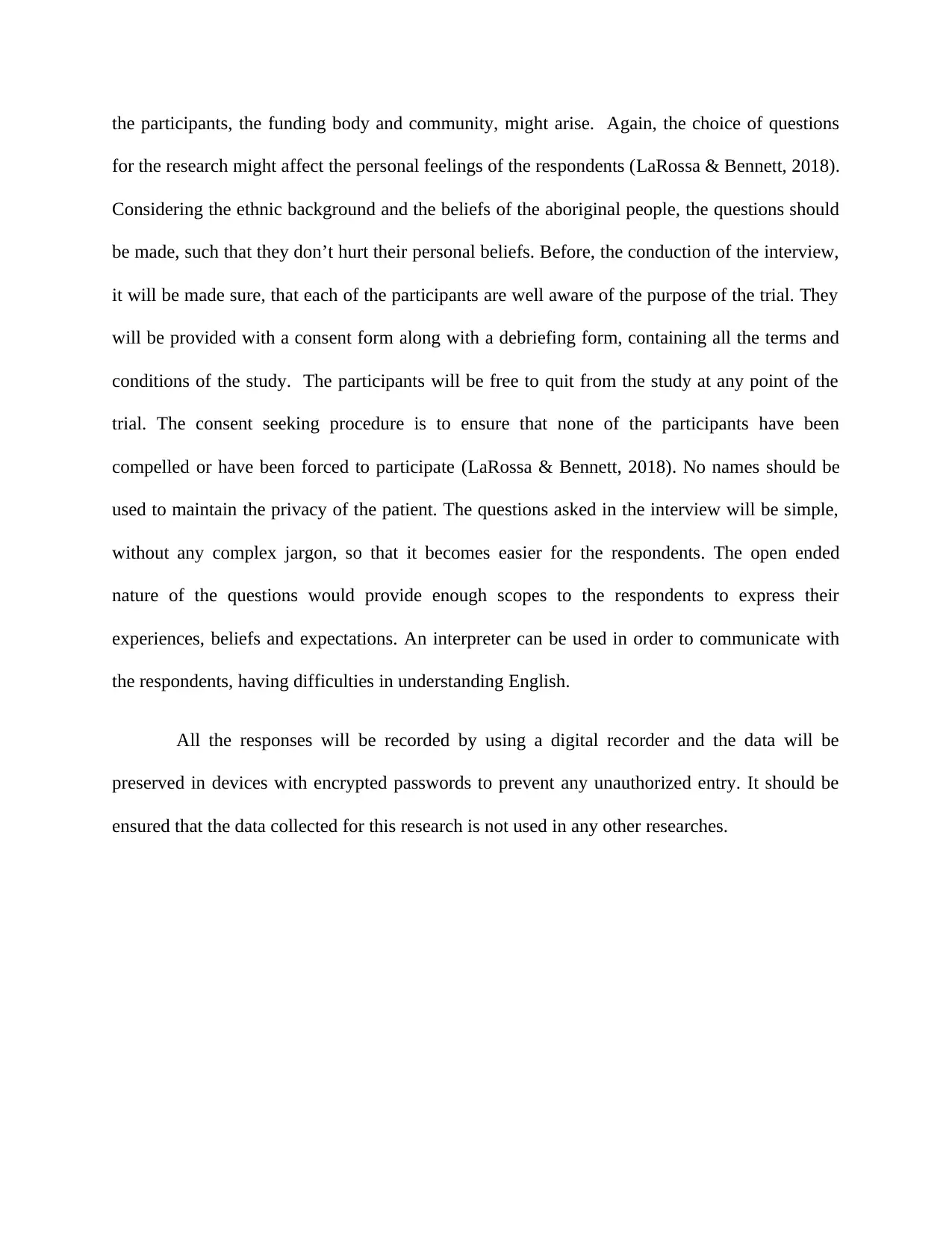
the participants, the funding body and community, might arise. Again, the choice of questions
for the research might affect the personal feelings of the respondents (LaRossa & Bennett, 2018).
Considering the ethnic background and the beliefs of the aboriginal people, the questions should
be made, such that they don’t hurt their personal beliefs. Before, the conduction of the interview,
it will be made sure, that each of the participants are well aware of the purpose of the trial. They
will be provided with a consent form along with a debriefing form, containing all the terms and
conditions of the study. The participants will be free to quit from the study at any point of the
trial. The consent seeking procedure is to ensure that none of the participants have been
compelled or have been forced to participate (LaRossa & Bennett, 2018). No names should be
used to maintain the privacy of the patient. The questions asked in the interview will be simple,
without any complex jargon, so that it becomes easier for the respondents. The open ended
nature of the questions would provide enough scopes to the respondents to express their
experiences, beliefs and expectations. An interpreter can be used in order to communicate with
the respondents, having difficulties in understanding English.
All the responses will be recorded by using a digital recorder and the data will be
preserved in devices with encrypted passwords to prevent any unauthorized entry. It should be
ensured that the data collected for this research is not used in any other researches.
for the research might affect the personal feelings of the respondents (LaRossa & Bennett, 2018).
Considering the ethnic background and the beliefs of the aboriginal people, the questions should
be made, such that they don’t hurt their personal beliefs. Before, the conduction of the interview,
it will be made sure, that each of the participants are well aware of the purpose of the trial. They
will be provided with a consent form along with a debriefing form, containing all the terms and
conditions of the study. The participants will be free to quit from the study at any point of the
trial. The consent seeking procedure is to ensure that none of the participants have been
compelled or have been forced to participate (LaRossa & Bennett, 2018). No names should be
used to maintain the privacy of the patient. The questions asked in the interview will be simple,
without any complex jargon, so that it becomes easier for the respondents. The open ended
nature of the questions would provide enough scopes to the respondents to express their
experiences, beliefs and expectations. An interpreter can be used in order to communicate with
the respondents, having difficulties in understanding English.
All the responses will be recorded by using a digital recorder and the data will be
preserved in devices with encrypted passwords to prevent any unauthorized entry. It should be
ensured that the data collected for this research is not used in any other researches.
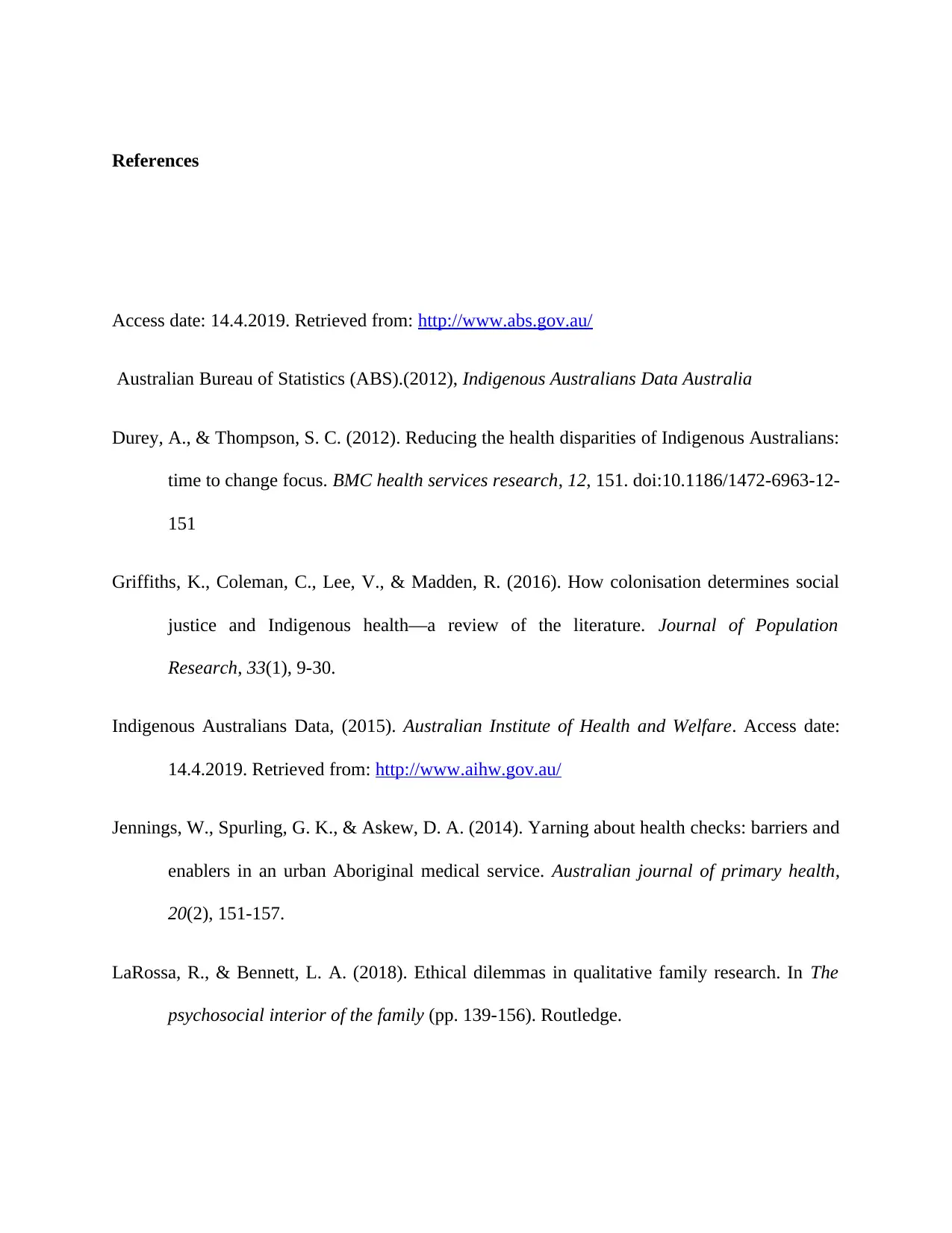
References
Access date: 14.4.2019. Retrieved from: http://www.abs.gov.au/
Australian Bureau of Statistics (ABS).(2012), Indigenous Australians Data Australia
Durey, A., & Thompson, S. C. (2012). Reducing the health disparities of Indigenous Australians:
time to change focus. BMC health services research, 12, 151. doi:10.1186/1472-6963-12-
151
Griffiths, K., Coleman, C., Lee, V., & Madden, R. (2016). How colonisation determines social
justice and Indigenous health—a review of the literature. Journal of Population
Research, 33(1), 9-30.
Indigenous Australians Data, (2015). Australian Institute of Health and Welfare. Access date:
14.4.2019. Retrieved from: http://www.aihw.gov.au/
Jennings, W., Spurling, G. K., & Askew, D. A. (2014). Yarning about health checks: barriers and
enablers in an urban Aboriginal medical service. Australian journal of primary health,
20(2), 151-157.
LaRossa, R., & Bennett, L. A. (2018). Ethical dilemmas in qualitative family research. In The
psychosocial interior of the family (pp. 139-156). Routledge.
Access date: 14.4.2019. Retrieved from: http://www.abs.gov.au/
Australian Bureau of Statistics (ABS).(2012), Indigenous Australians Data Australia
Durey, A., & Thompson, S. C. (2012). Reducing the health disparities of Indigenous Australians:
time to change focus. BMC health services research, 12, 151. doi:10.1186/1472-6963-12-
151
Griffiths, K., Coleman, C., Lee, V., & Madden, R. (2016). How colonisation determines social
justice and Indigenous health—a review of the literature. Journal of Population
Research, 33(1), 9-30.
Indigenous Australians Data, (2015). Australian Institute of Health and Welfare. Access date:
14.4.2019. Retrieved from: http://www.aihw.gov.au/
Jennings, W., Spurling, G. K., & Askew, D. A. (2014). Yarning about health checks: barriers and
enablers in an urban Aboriginal medical service. Australian journal of primary health,
20(2), 151-157.
LaRossa, R., & Bennett, L. A. (2018). Ethical dilemmas in qualitative family research. In The
psychosocial interior of the family (pp. 139-156). Routledge.
Secure Best Marks with AI Grader
Need help grading? Try our AI Grader for instant feedback on your assignments.
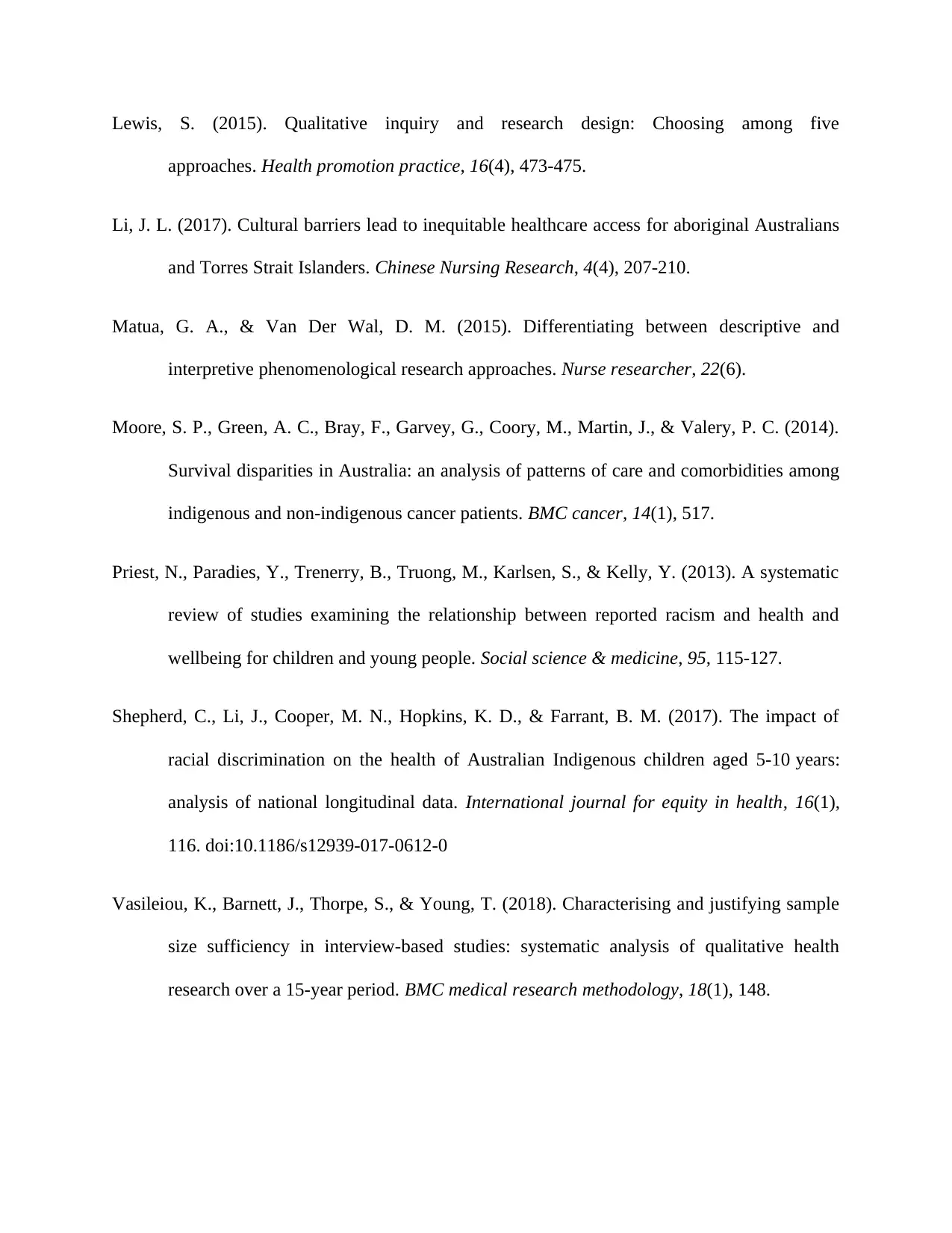
Lewis, S. (2015). Qualitative inquiry and research design: Choosing among five
approaches. Health promotion practice, 16(4), 473-475.
Li, J. L. (2017). Cultural barriers lead to inequitable healthcare access for aboriginal Australians
and Torres Strait Islanders. Chinese Nursing Research, 4(4), 207-210.
Matua, G. A., & Van Der Wal, D. M. (2015). Differentiating between descriptive and
interpretive phenomenological research approaches. Nurse researcher, 22(6).
Moore, S. P., Green, A. C., Bray, F., Garvey, G., Coory, M., Martin, J., & Valery, P. C. (2014).
Survival disparities in Australia: an analysis of patterns of care and comorbidities among
indigenous and non-indigenous cancer patients. BMC cancer, 14(1), 517.
Priest, N., Paradies, Y., Trenerry, B., Truong, M., Karlsen, S., & Kelly, Y. (2013). A systematic
review of studies examining the relationship between reported racism and health and
wellbeing for children and young people. Social science & medicine, 95, 115-127.
Shepherd, C., Li, J., Cooper, M. N., Hopkins, K. D., & Farrant, B. M. (2017). The impact of
racial discrimination on the health of Australian Indigenous children aged 5-10 years:
analysis of national longitudinal data. International journal for equity in health, 16(1),
116. doi:10.1186/s12939-017-0612-0
Vasileiou, K., Barnett, J., Thorpe, S., & Young, T. (2018). Characterising and justifying sample
size sufficiency in interview-based studies: systematic analysis of qualitative health
research over a 15-year period. BMC medical research methodology, 18(1), 148.
approaches. Health promotion practice, 16(4), 473-475.
Li, J. L. (2017). Cultural barriers lead to inequitable healthcare access for aboriginal Australians
and Torres Strait Islanders. Chinese Nursing Research, 4(4), 207-210.
Matua, G. A., & Van Der Wal, D. M. (2015). Differentiating between descriptive and
interpretive phenomenological research approaches. Nurse researcher, 22(6).
Moore, S. P., Green, A. C., Bray, F., Garvey, G., Coory, M., Martin, J., & Valery, P. C. (2014).
Survival disparities in Australia: an analysis of patterns of care and comorbidities among
indigenous and non-indigenous cancer patients. BMC cancer, 14(1), 517.
Priest, N., Paradies, Y., Trenerry, B., Truong, M., Karlsen, S., & Kelly, Y. (2013). A systematic
review of studies examining the relationship between reported racism and health and
wellbeing for children and young people. Social science & medicine, 95, 115-127.
Shepherd, C., Li, J., Cooper, M. N., Hopkins, K. D., & Farrant, B. M. (2017). The impact of
racial discrimination on the health of Australian Indigenous children aged 5-10 years:
analysis of national longitudinal data. International journal for equity in health, 16(1),
116. doi:10.1186/s12939-017-0612-0
Vasileiou, K., Barnett, J., Thorpe, S., & Young, T. (2018). Characterising and justifying sample
size sufficiency in interview-based studies: systematic analysis of qualitative health
research over a 15-year period. BMC medical research methodology, 18(1), 148.
1 out of 11
Related Documents
Your All-in-One AI-Powered Toolkit for Academic Success.
+13062052269
info@desklib.com
Available 24*7 on WhatsApp / Email
![[object Object]](/_next/static/media/star-bottom.7253800d.svg)
Unlock your academic potential
© 2024 | Zucol Services PVT LTD | All rights reserved.





